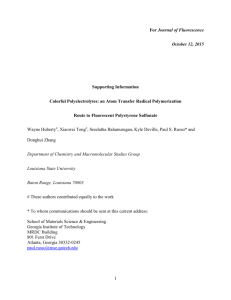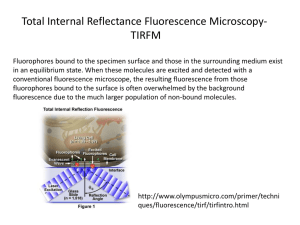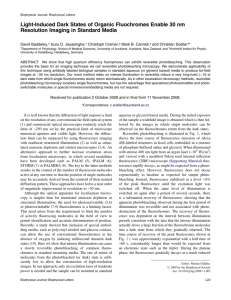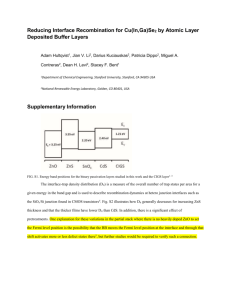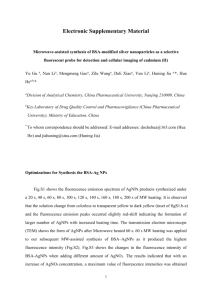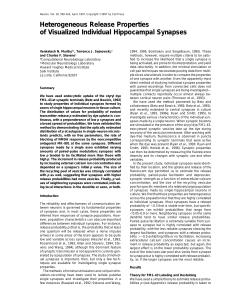Word file (70 KB )
advertisement
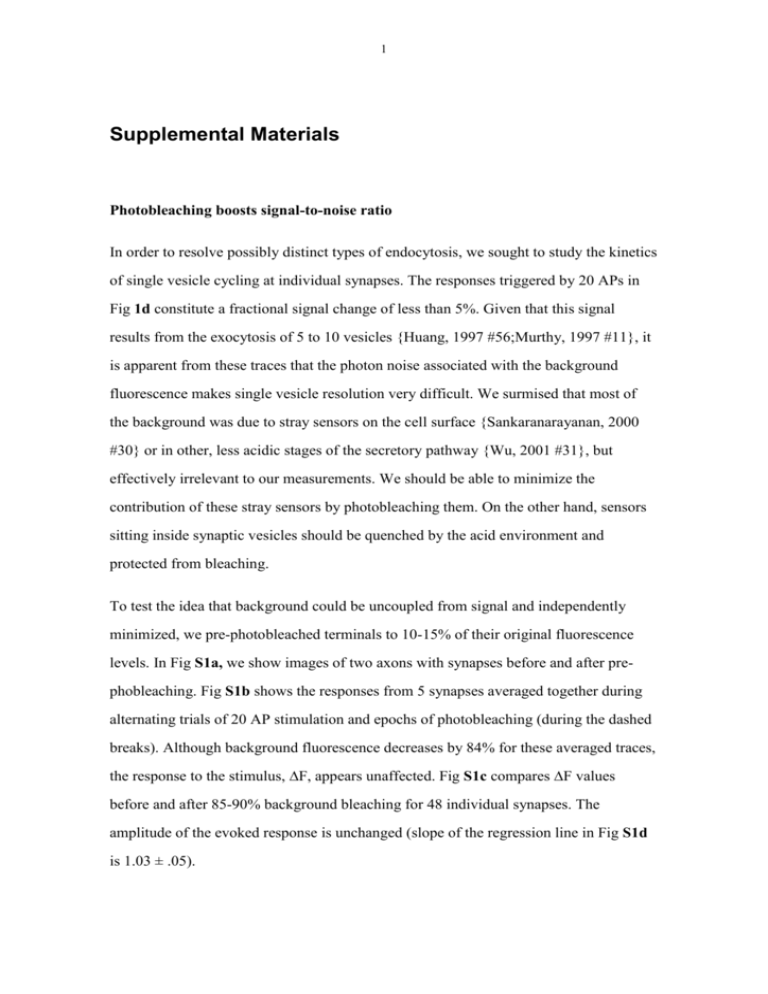
1
Supplemental Materials
Photobleaching boosts signal-to-noise ratio
In order to resolve possibly distinct types of endocytosis, we sought to study the kinetics
of single vesicle cycling at individual synapses. The responses triggered by 20 APs in
Fig 1d constitute a fractional signal change of less than 5%. Given that this signal
results from the exocytosis of 5 to 10 vesicles {Huang, 1997 #56;Murthy, 1997 #11}, it
is apparent from these traces that the photon noise associated with the background
fluorescence makes single vesicle resolution very difficult. We surmised that most of
the background was due to stray sensors on the cell surface {Sankaranarayanan, 2000
#30} or in other, less acidic stages of the secretory pathway {Wu, 2001 #31}, but
effectively irrelevant to our measurements. We should be able to minimize the
contribution of these stray sensors by photobleaching them. On the other hand, sensors
sitting inside synaptic vesicles should be quenched by the acid environment and
protected from bleaching.
To test the idea that background could be uncoupled from signal and independently
minimized, we pre-photobleached terminals to 10-15% of their original fluorescence
levels. In Fig S1a, we show images of two axons with synapses before and after prephobleaching. Fig S1b shows the responses from 5 synapses averaged together during
alternating trials of 20 AP stimulation and epochs of photobleaching (during the dashed
breaks). Although background fluorescence decreases by 84% for these averaged traces,
the response to the stimulus, F, appears unaffected. Fig S1c compares F values
before and after 85-90% background bleaching for 48 individual synapses. The
amplitude of the evoked response is unchanged (slope of the regression line in Fig S1d
is 1.03 ± .05).
2
In order to quantify the signal-to-noise improvement we plotted the ratio of F to the
background fluorescence standard deviation as a function of background fluorescence
intensity for 80 synapses at various stages of photobleaching (Fig S1). Fig S1 shows
these ratios binned by background value and averaged. The predicted relationship (see
methods) reaches 12 in asymptotically bleached synapses. Given that 20 APs elicit
around 5-10 release events, the per-vesicle signal-to-noise ratio approaches 2-to-1 with
photobleaching.
Figure S1. Photobleaching background fluorescence improves signal-to-noise
ratio (S/N). a. Images before (top) and after(bottom) photobleaching for 42
minutes. b. Average time course for 5 synapses across alternating trials of 20
AP stimulation and photobleaching (during dashed breaks). Whereas
background fluorescence, F, goes down 84%, the response F does not. C.
Comparison of F responses measured during the photobleaching process
which produced 85 – 90% attenuation of F (n=48). Points fall along unity (slope
= 1.03 ± 0.05); bleaching has no effect on F. d. Plots fo the average S/N (F /
[F]) binned by F for 80 synapses. Examples of low and high S/N traces are
shown in the inset.
Signal-to-Noise Ratio Fit
The photon noise associated with a fluorescence signal F, whose average value is E(F),
is given by the equation
EF 2 F ,
3
where σ2(F) is the noise variance and is the gain per photon in detector units. This
rearranges to
1
F
E F
,
Given that a signal change F is small compared to the mean E(F), we obtain the signal
to noise relationship
F
F
E F
,
where F .
F, which is independent of E(F), was estimated as the mean of the data in Fig 2c
((F) = 91). was estimated from measurements using transmitted light focused onto
the detector (data not shown; = 3.70). The smooth curve in Fig 2d plots the
relationship above for the best fitting ( = 176), and closely agrees with the expected
value using these estimates for and ( = 175).
Buffer Theory
Let B = [buffer]bath, K = buffer dissociation constant, = endogenous buffer
concentration, f = [H+]free, and c = [H+]total.
When (B >> K), the buffer equation is
f
c
1 B
.
K
(i) Acidification of vesicles:
4
Let r be the H+ ion pump rate, and a the H+ leak rate. The quantity β, defined by the
relation
1
,
1 B K
describes the effect of the buffer. Without buffering, r H+ ions would enter the vesicle
per second. But most of these get buffered, so rß is the effective inflow rate. Assuming
simple kinetics, we write the equation for the concentration of free H+ ions as
df
r af .
dt
The steady state solution to this equation is
f
¥
=
rb æ
rö
1
= çç ÷
÷
÷1 + m + B
èç a ø
a
K
and the free H+ concentration settles according to
f (t ) = f¥ (1 - e- at ) + f (0)e- at
ær ö
1
= çç ÷
÷
÷1 + m + B
çè a ø
(1 - e- at ) + f (0)e- at
K
(ii) Buffer effect on the vesicle acidification time constant.
Suppose the fluorescence signal s depends on f according to a function G so that s =
G(f). Define a characteristic time of acidification by
1
ds
=
t ( B) dt
0
= G ¢( f 0 )
r
1 + m+ B
K
Then we have
( B)
(0)
1
1
B
K 1
B
(1 ) K
5
Thus ( B) (0)(1 AB) , where A
1
(1 ) K
, and the time constant for acidification
increases linearly with buffer concentration.
Let Bs = [buffer]surface, a term that accounts for the local interaction of buffer
with the access point to the vesicle lumen . Without saturation, B Bs , where θ
describes the relation between bulk and surface concentration Therefore
( B) (0)(1 AB) where A is estimated as the slope of the best linear fit to
(B) and (0) as the intercept.
Mean Pr
Fast S.E.M. (s)
Slow S.D. (s)
Low
0.20
0.727 0.176
—
average
0.30
1.09 0.224
8.16 1.31
High
0.42
0.869 0.155
11.7 3.26
standard calcium
0.26
0.860 0.210
10.4 0.35
high calcium
0.67
—
21.1 5.1
Table 1. Kinetics of kiss-and-run and compensatory modes. Low release probability synapses show no
measurable compensatory cycling in response to one action potential; synapses in high calcium solution
did not appreciably kiss-and-run cycle. Mono-exponential fits for kiss-and-run decay time course are the
same across release probabilities. Gaussian fits for compensatory cycling time course are slowed in high
calcium. True recycling times may be faster than these estimates depending upon acidification time.
6
